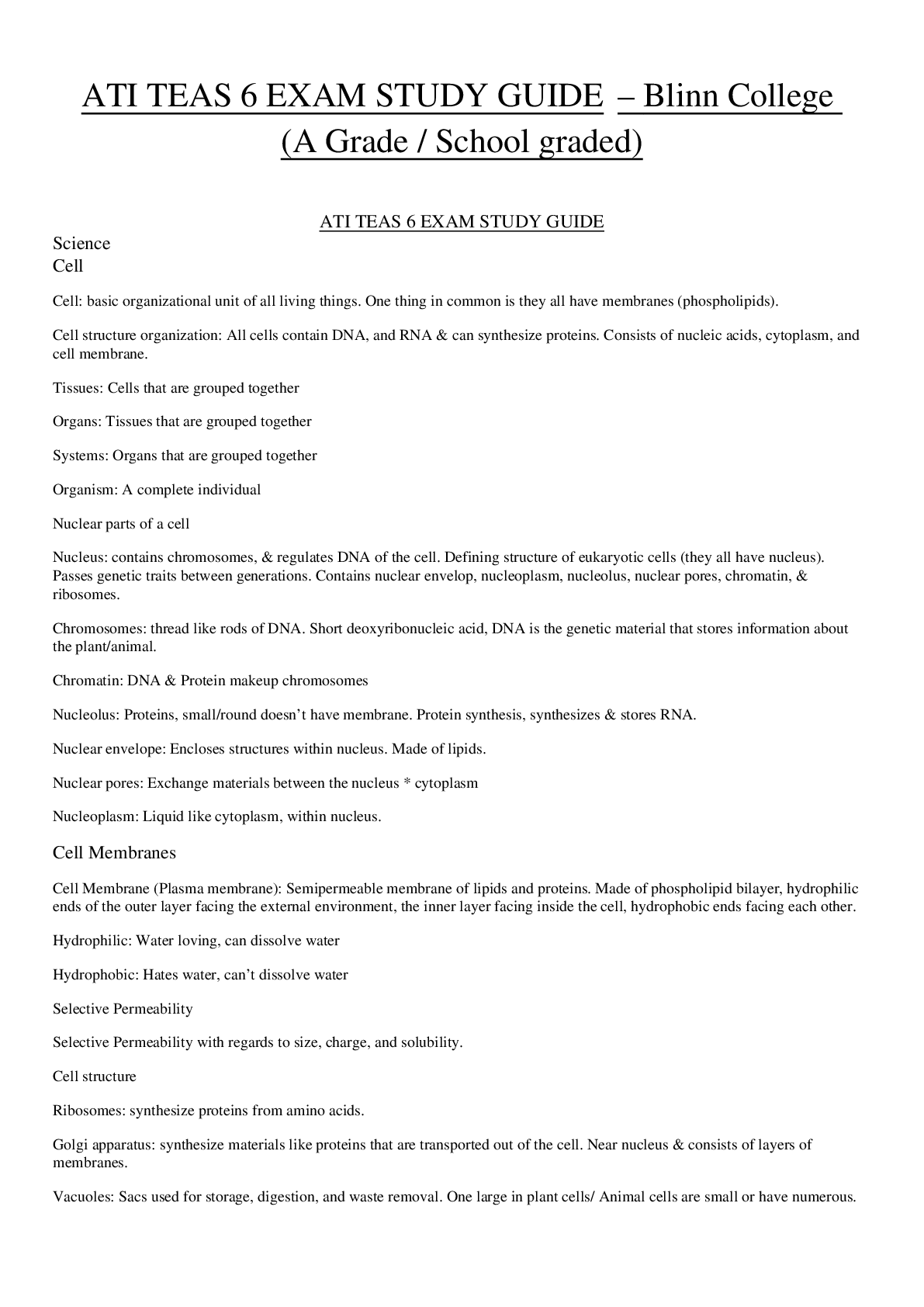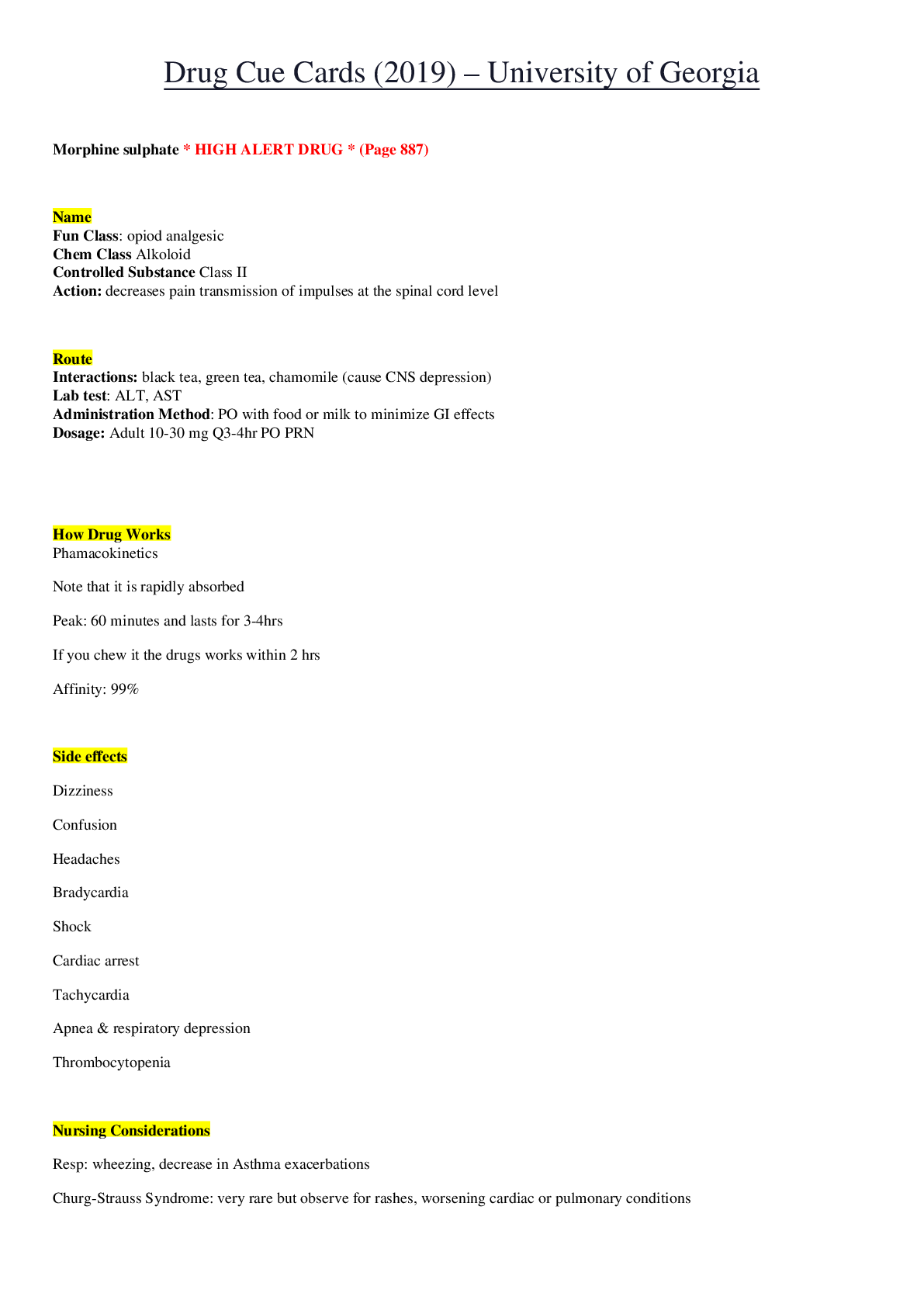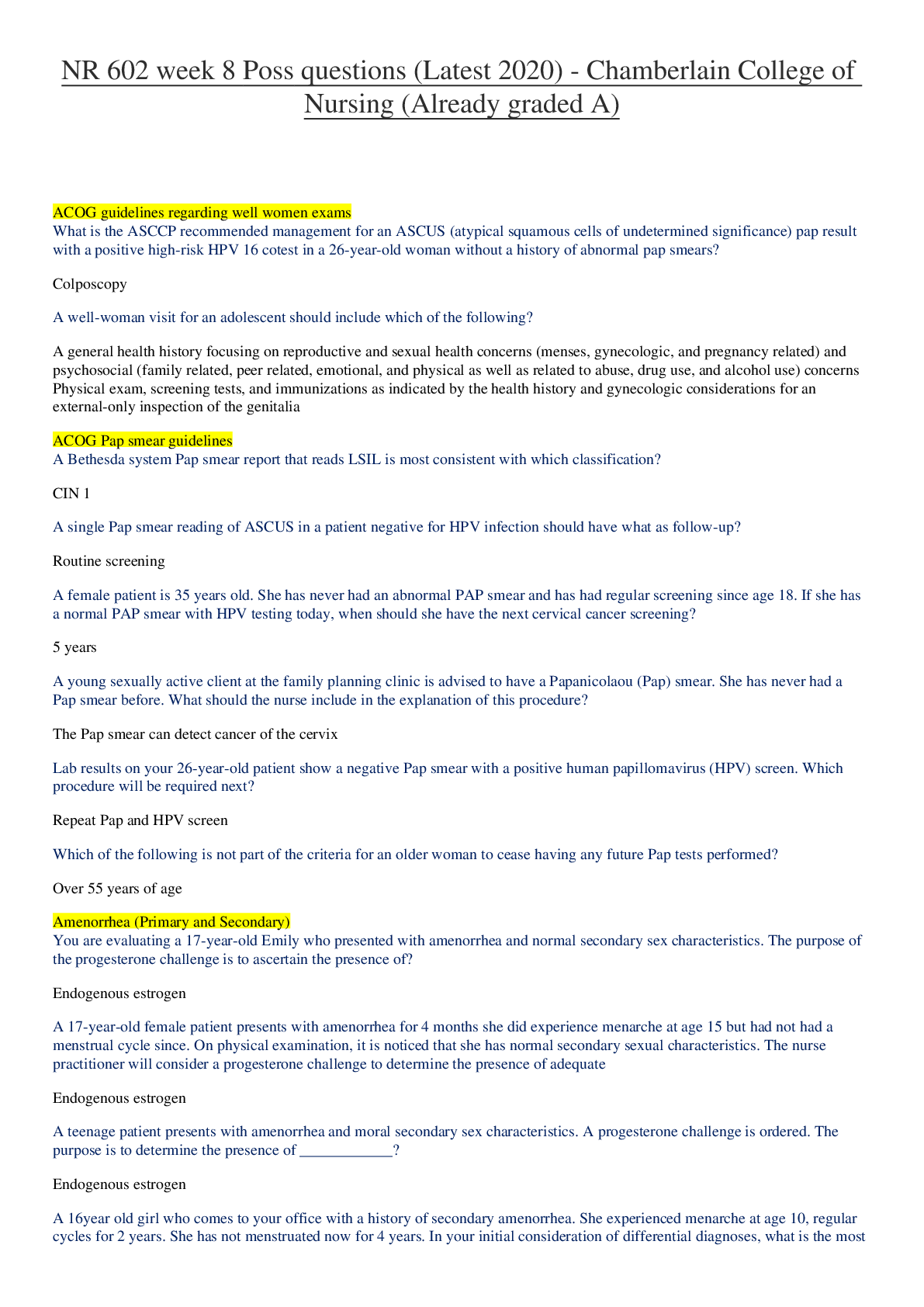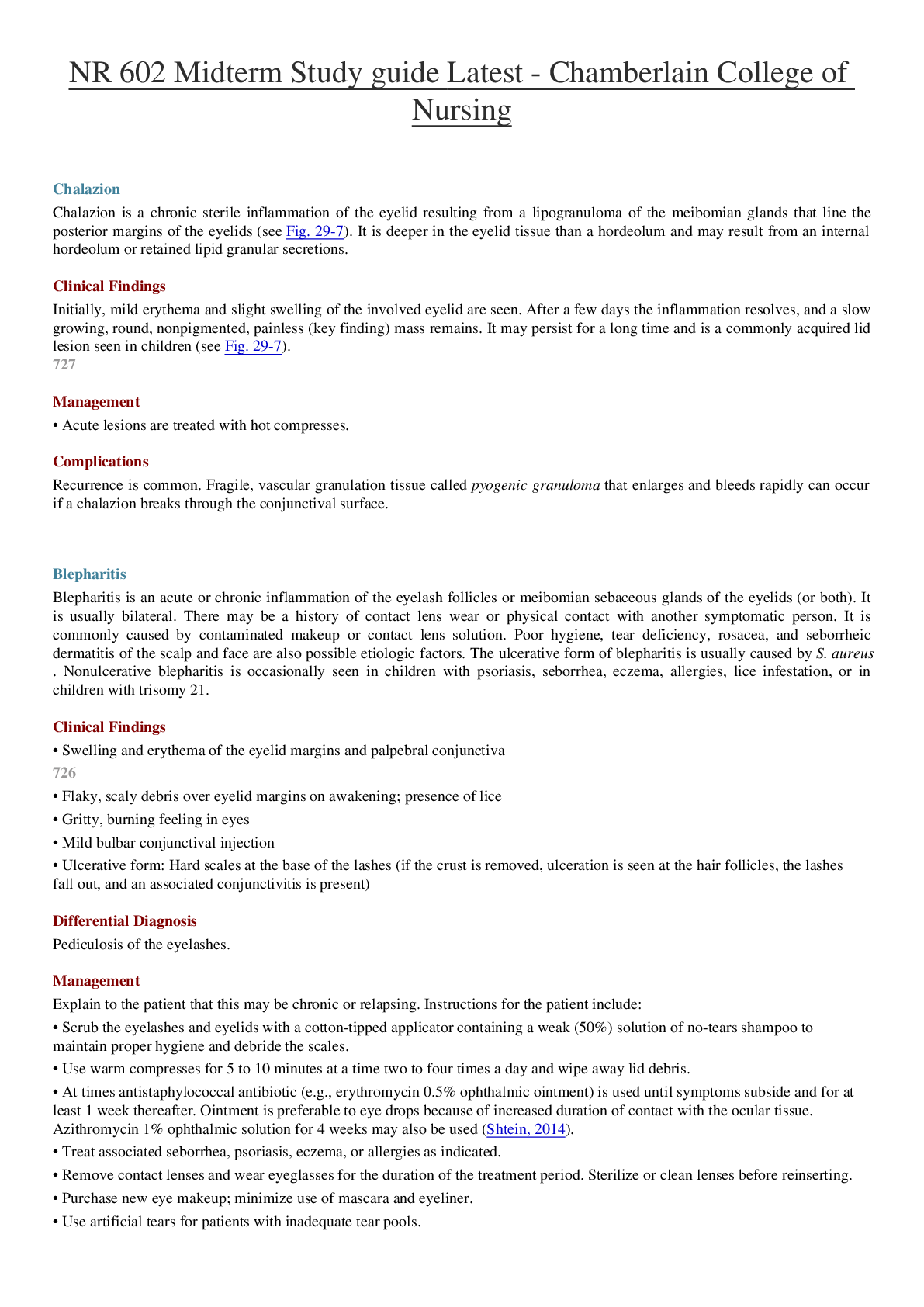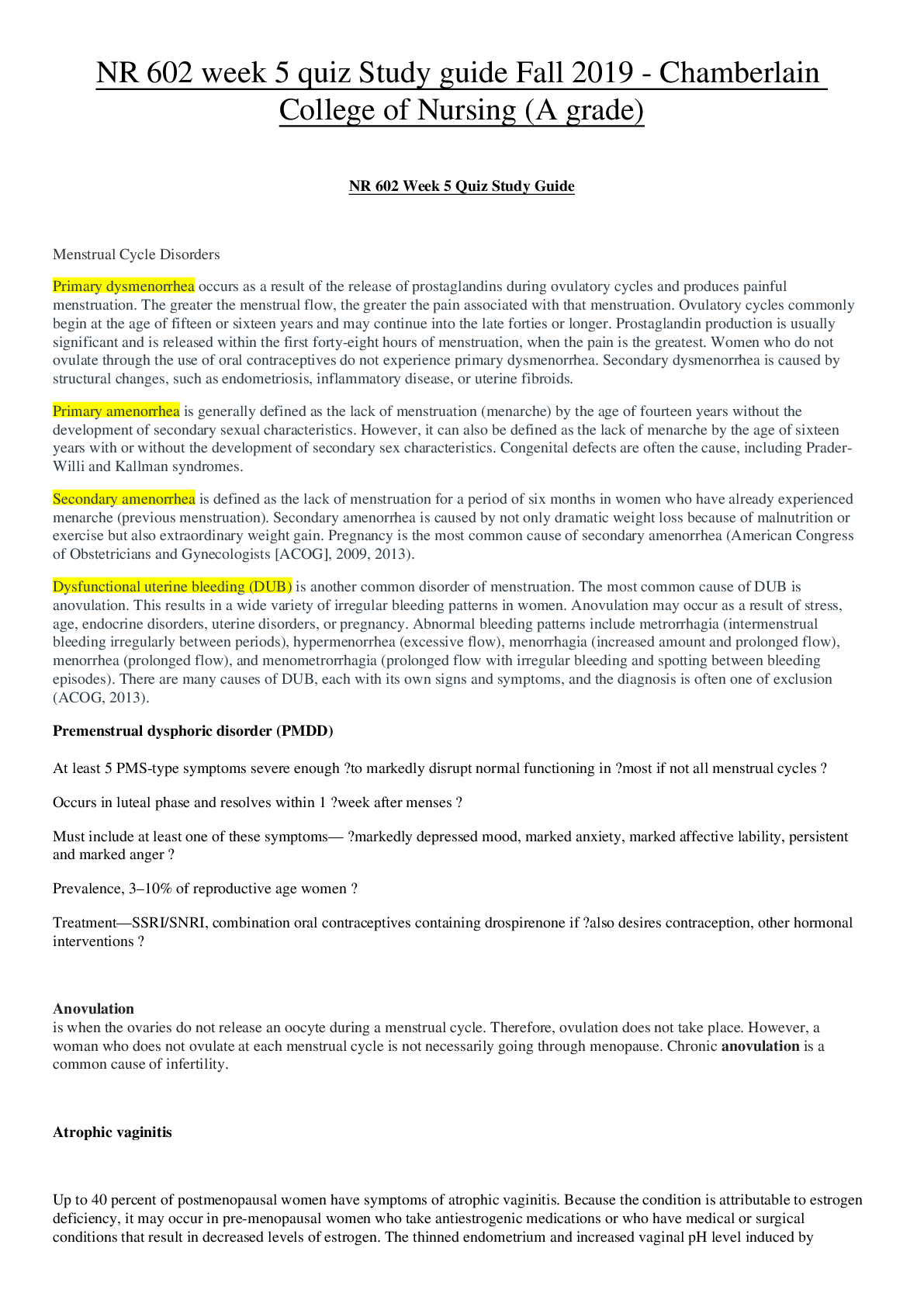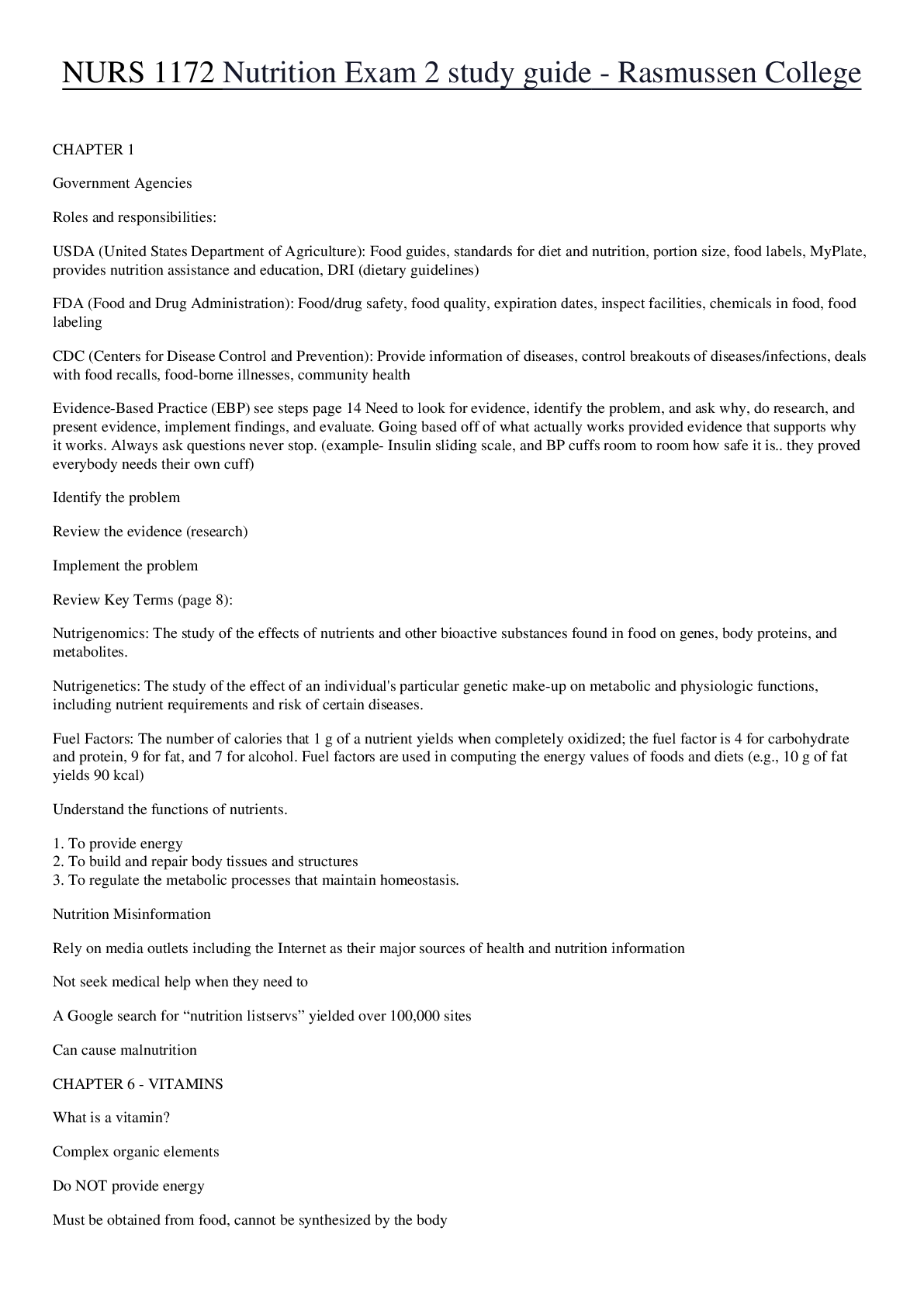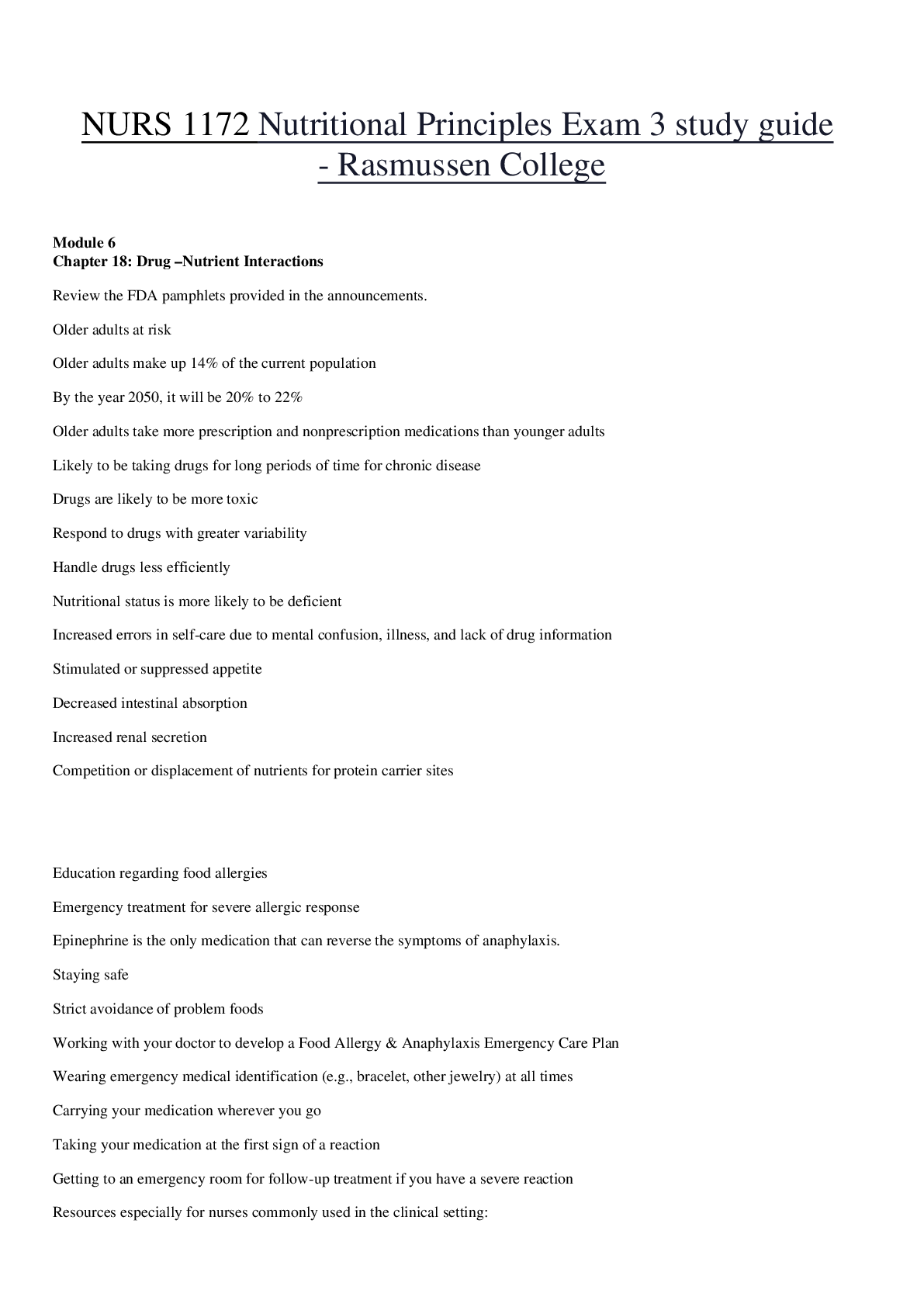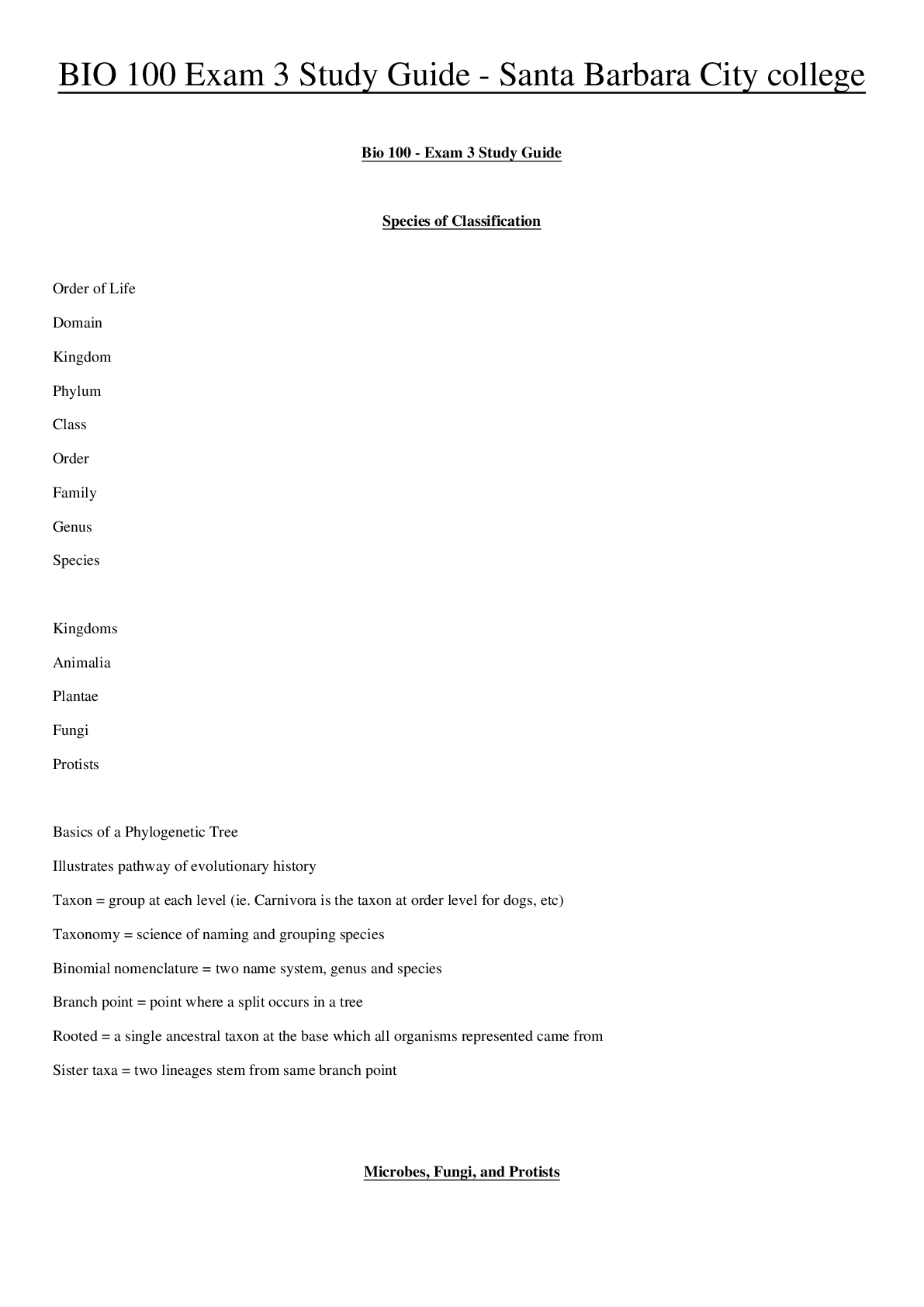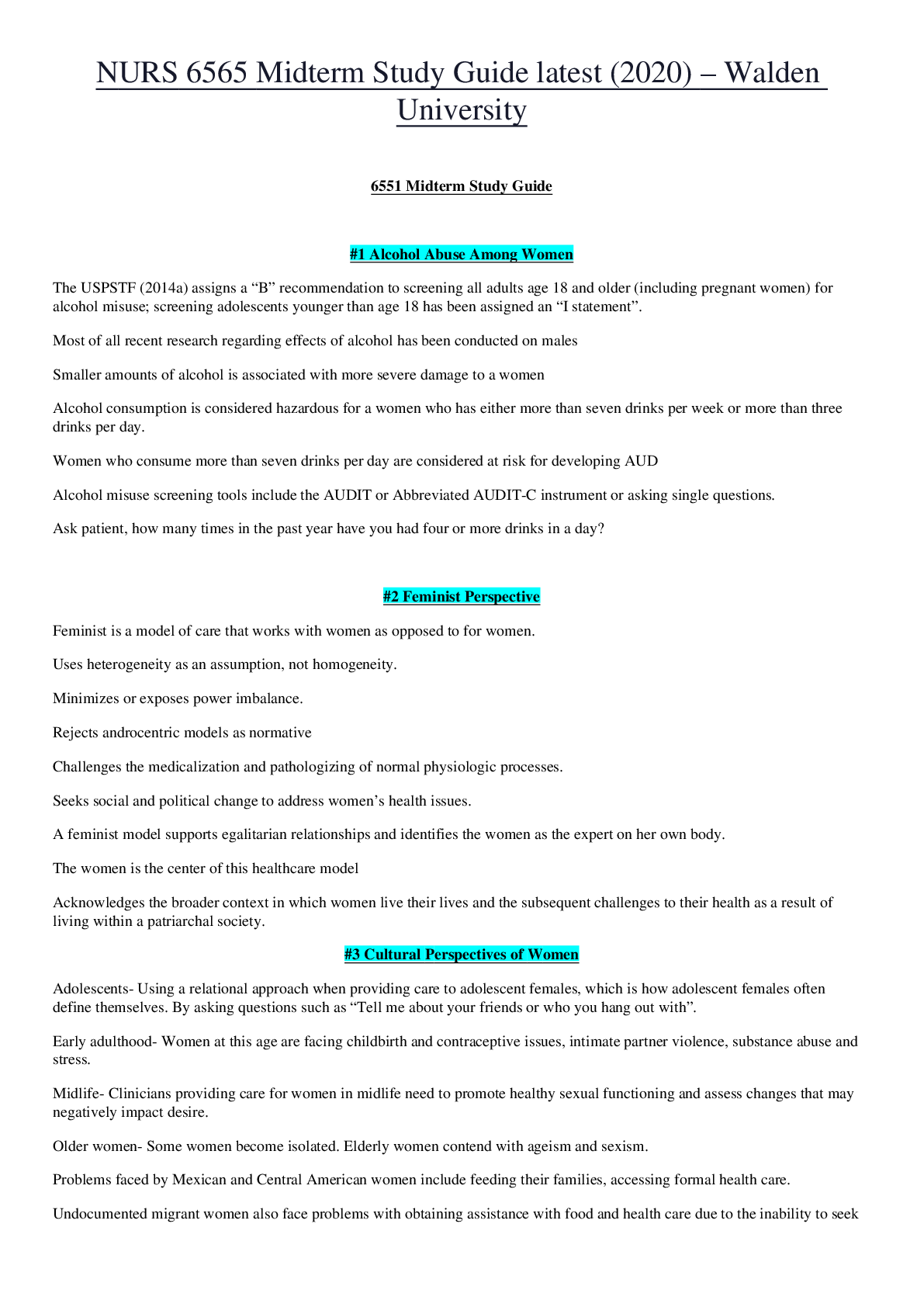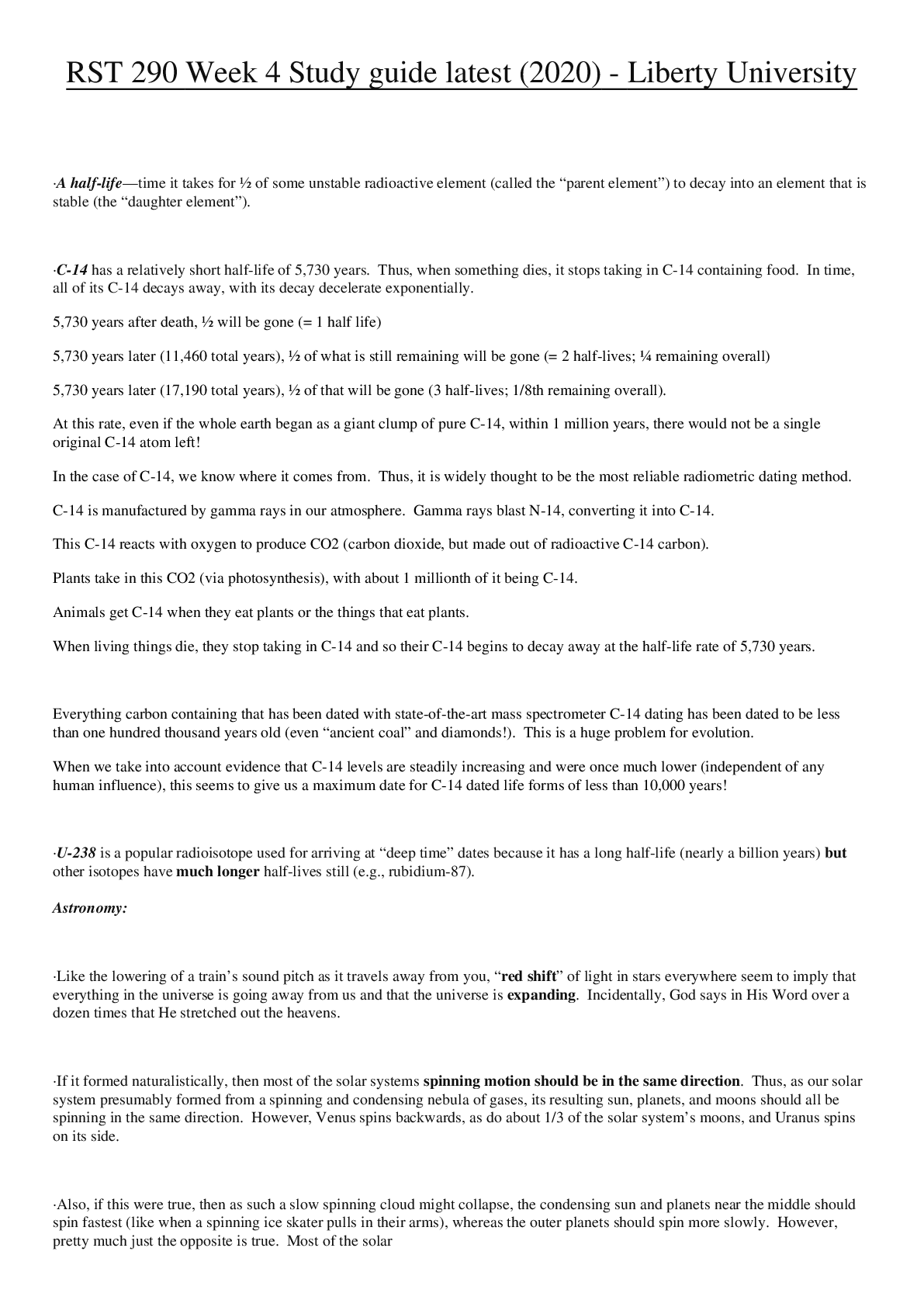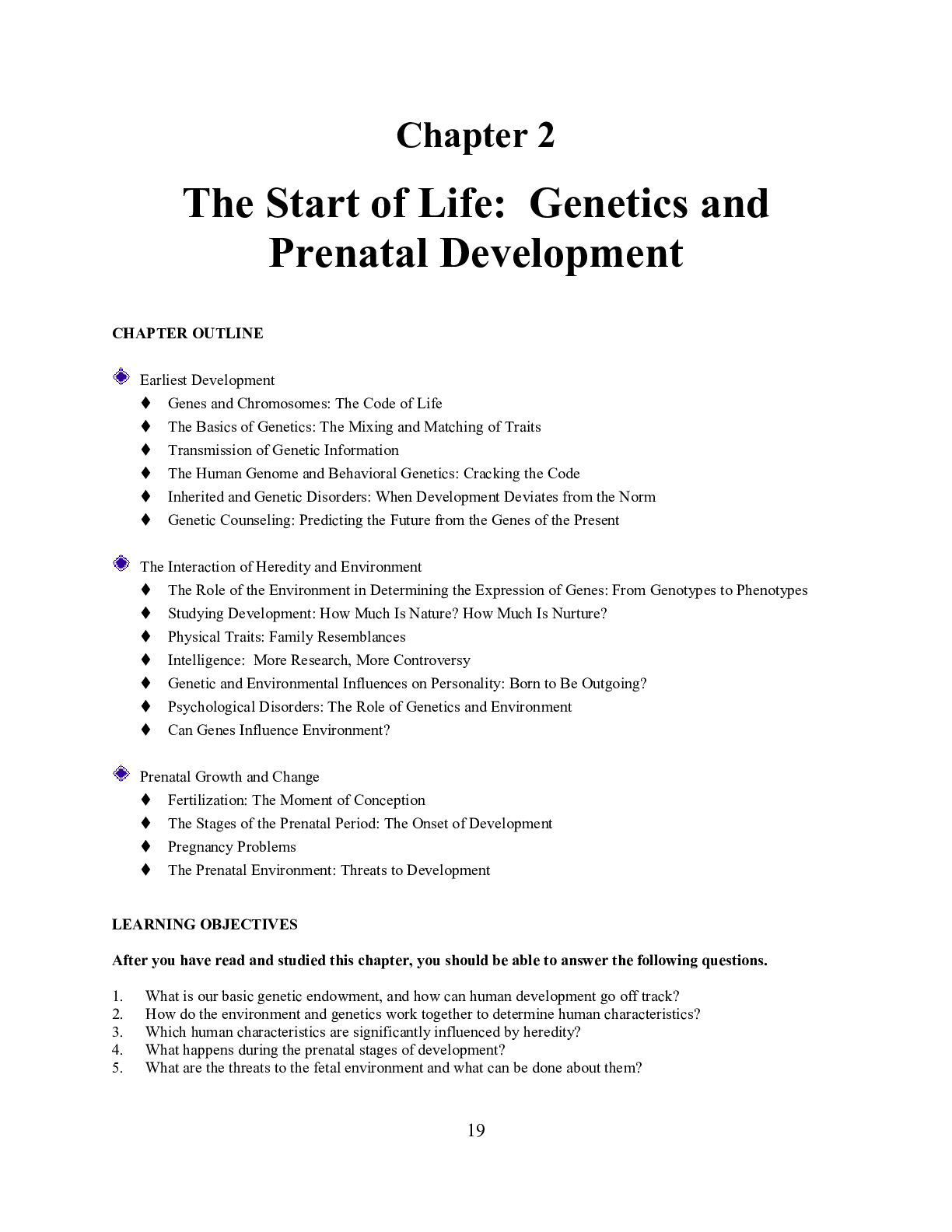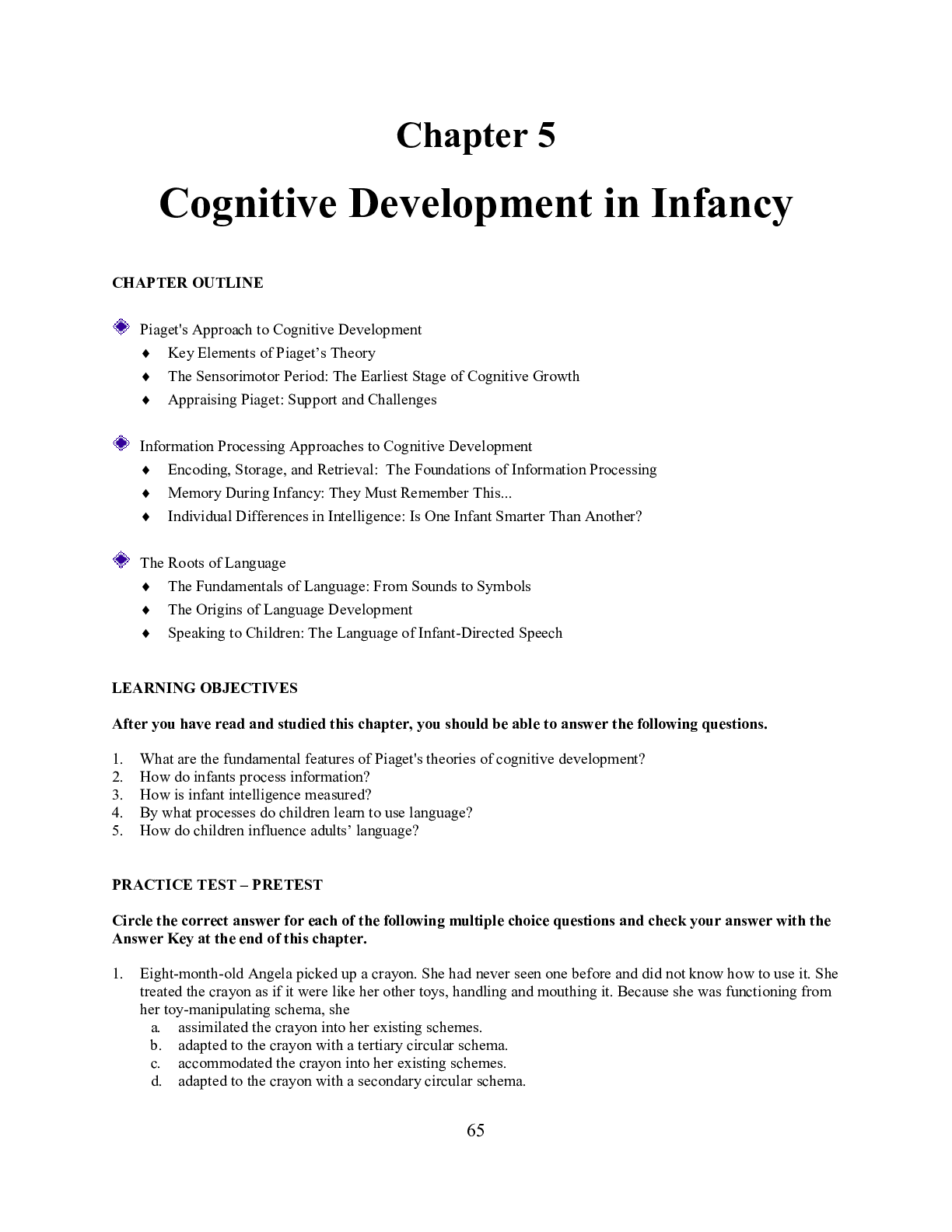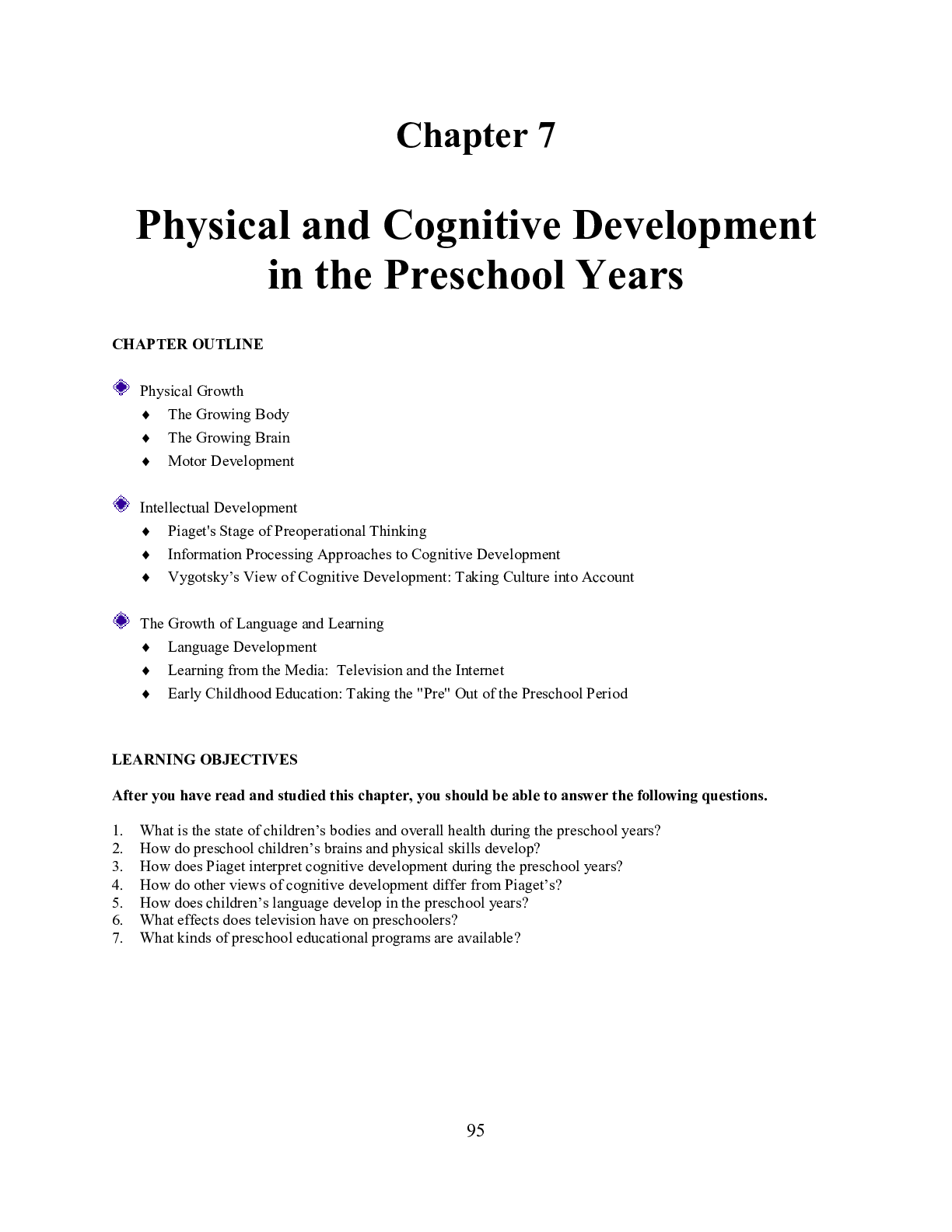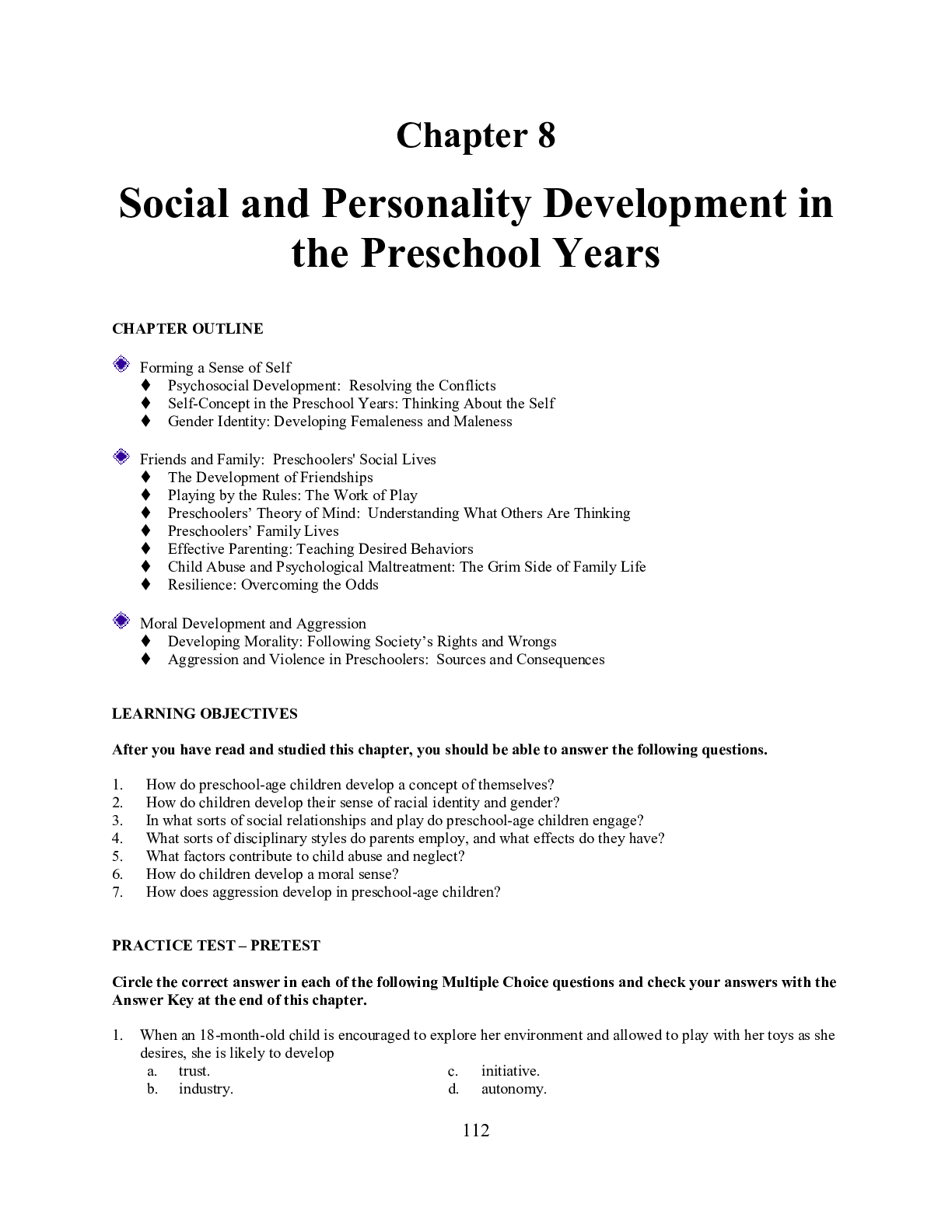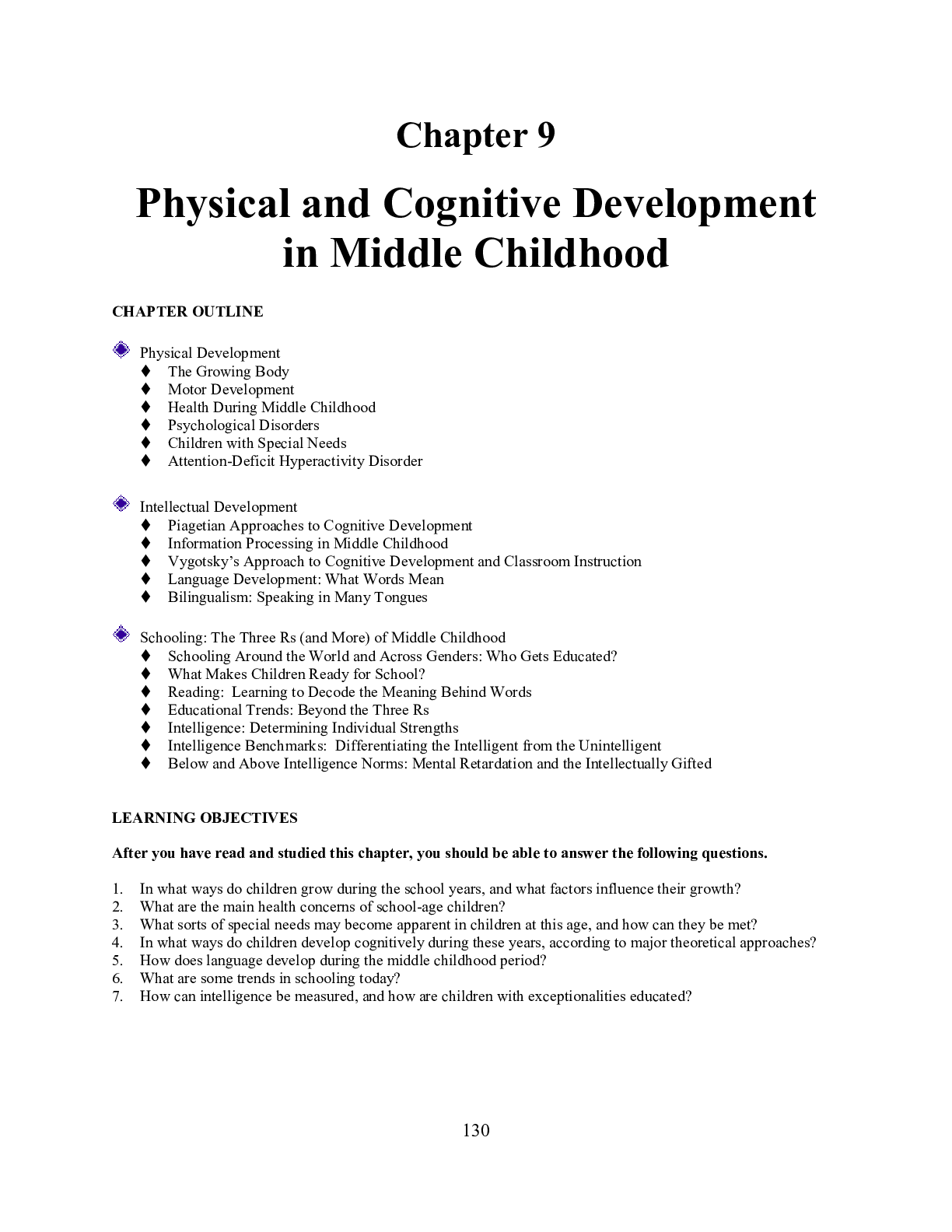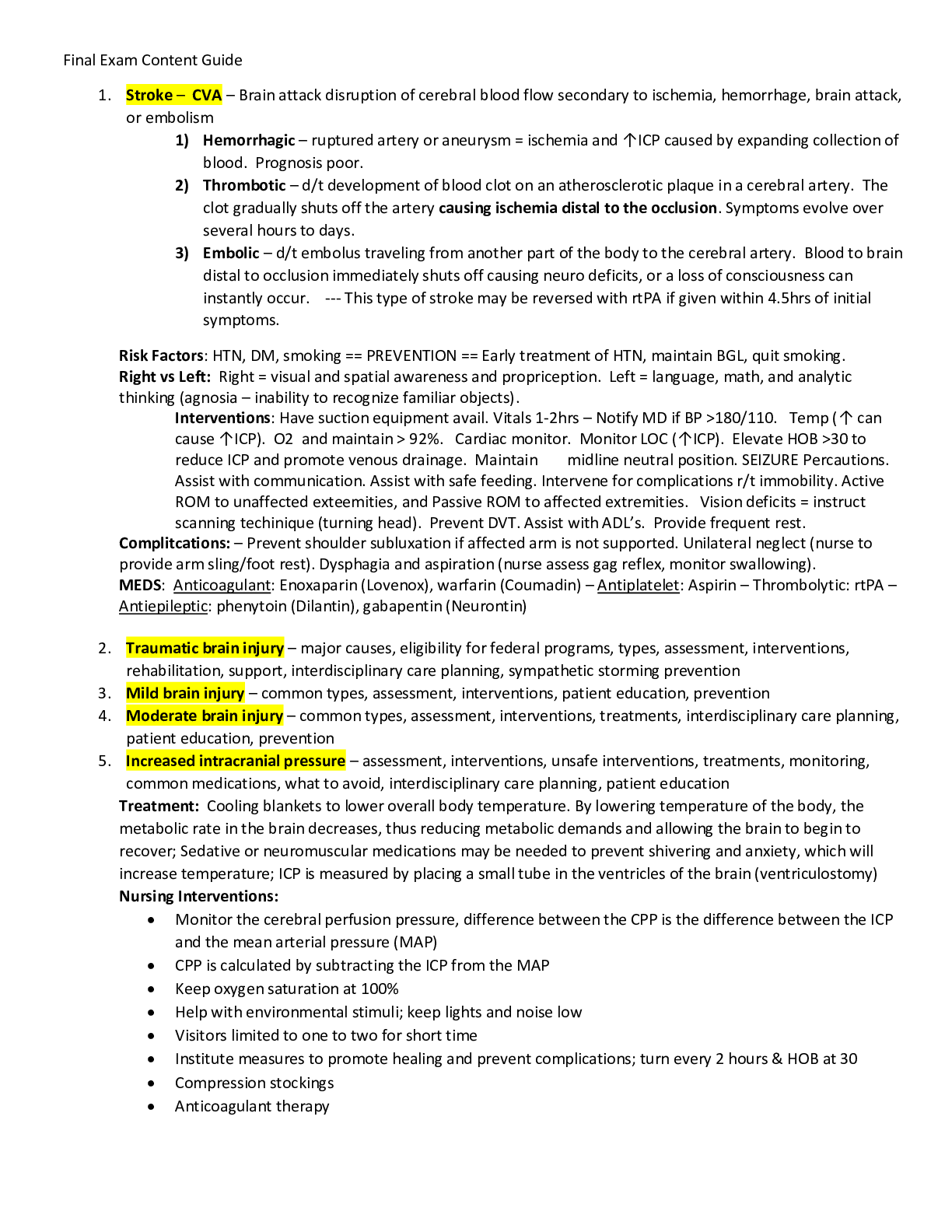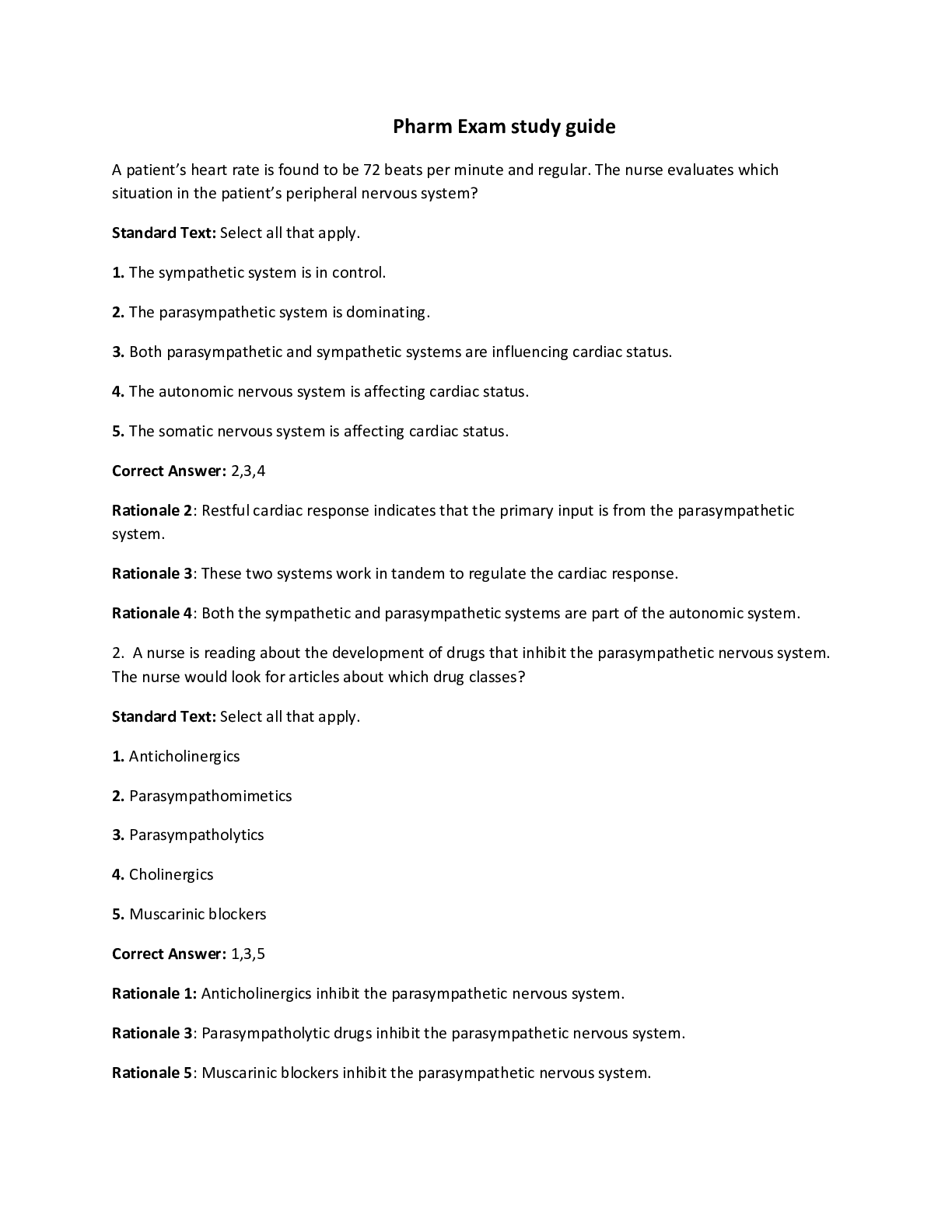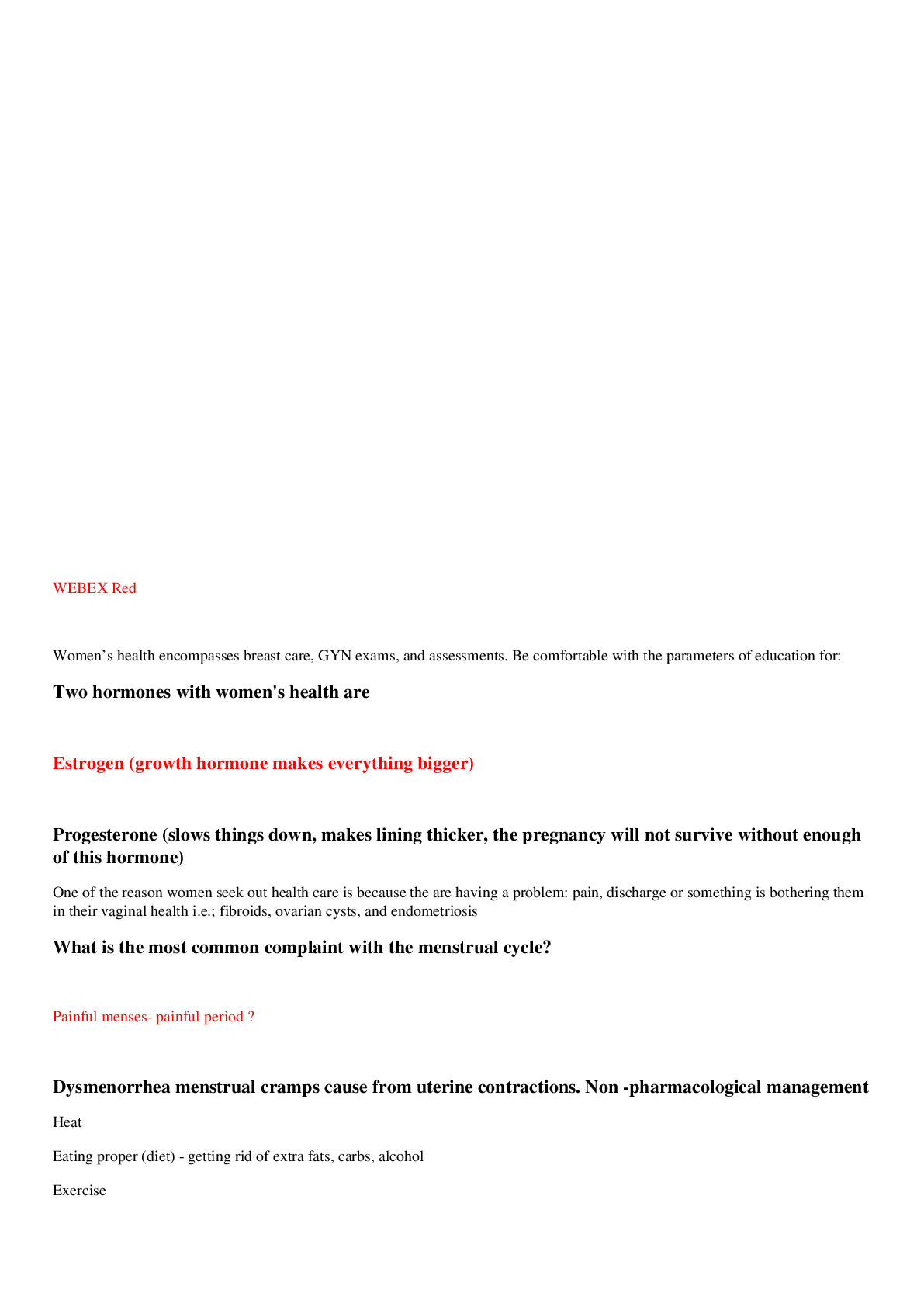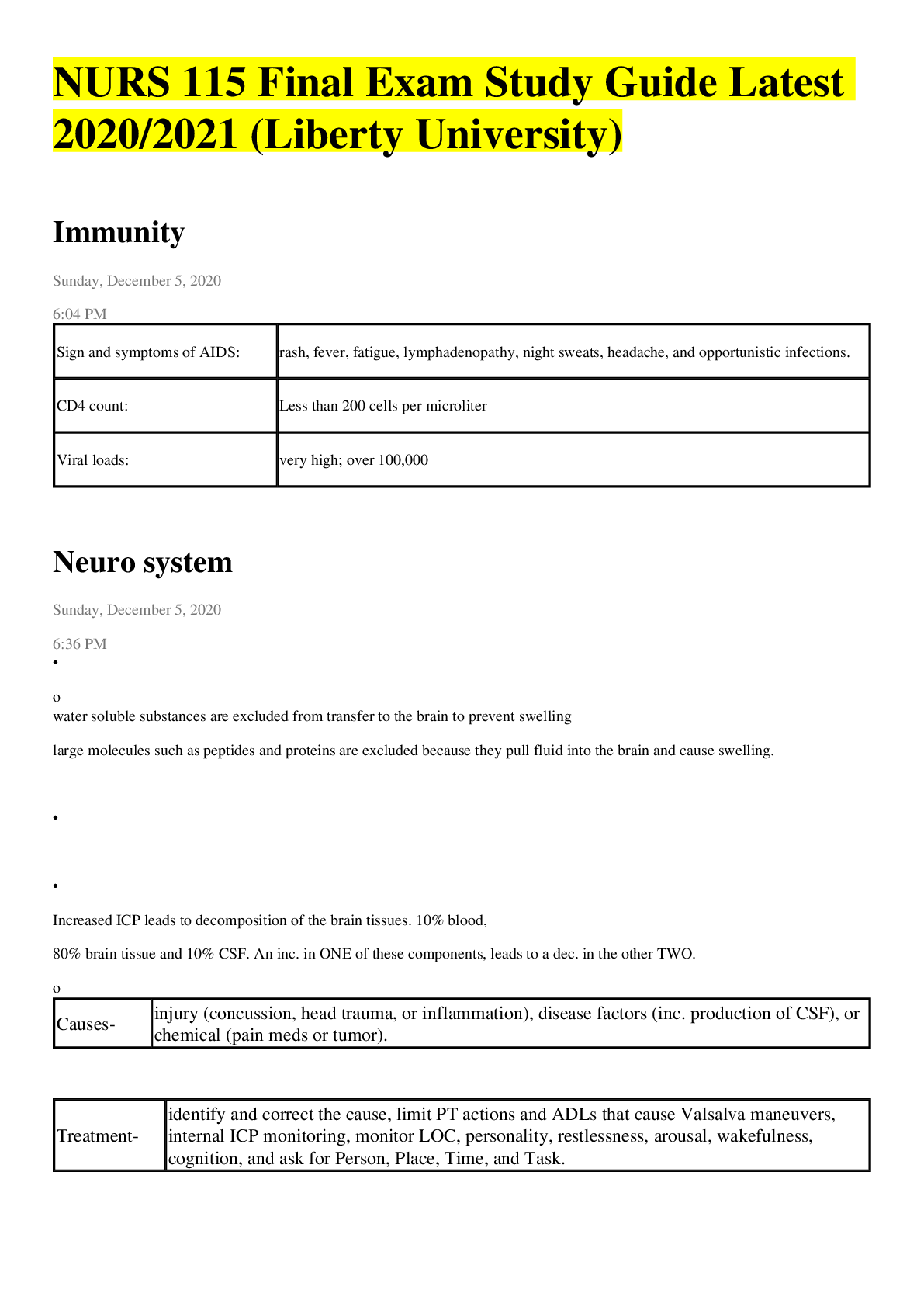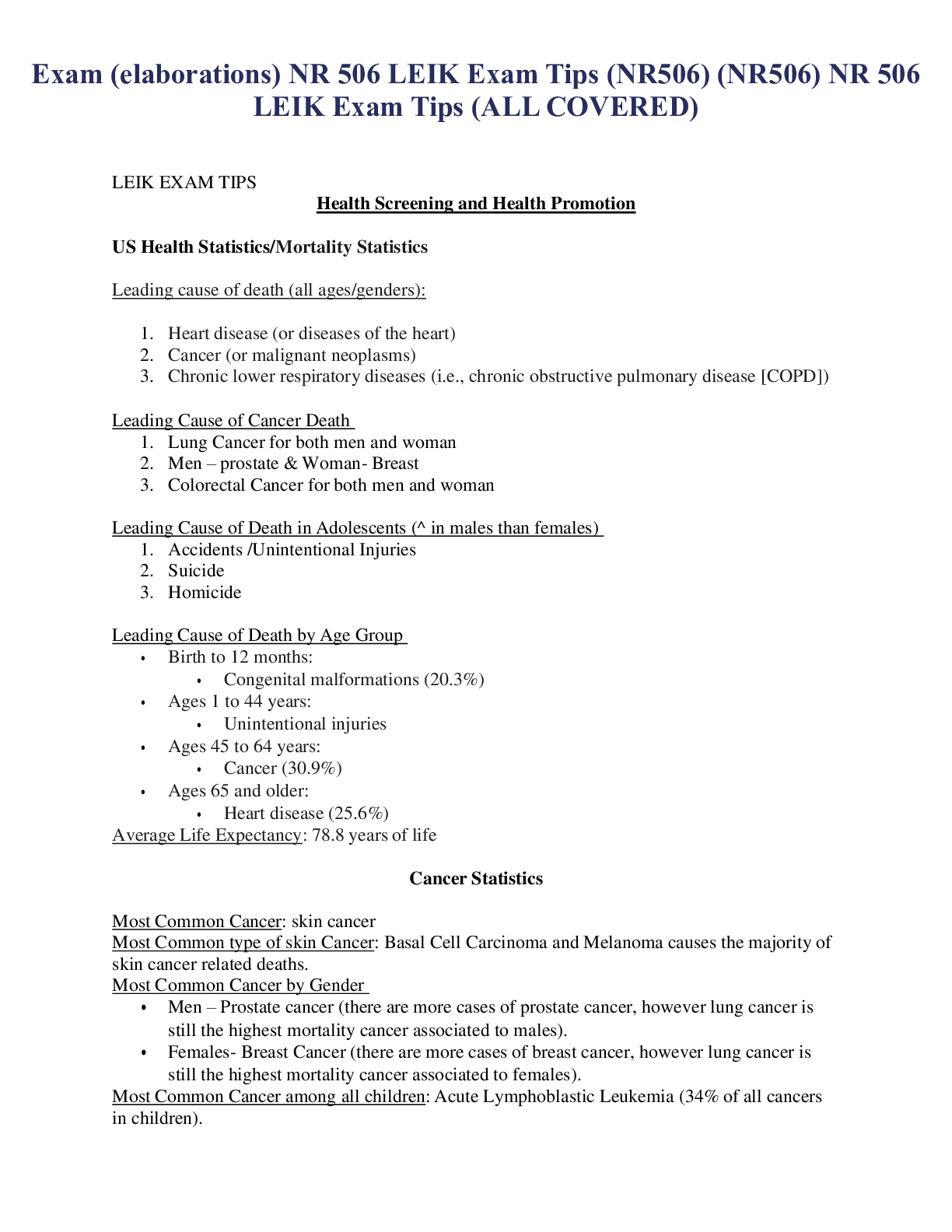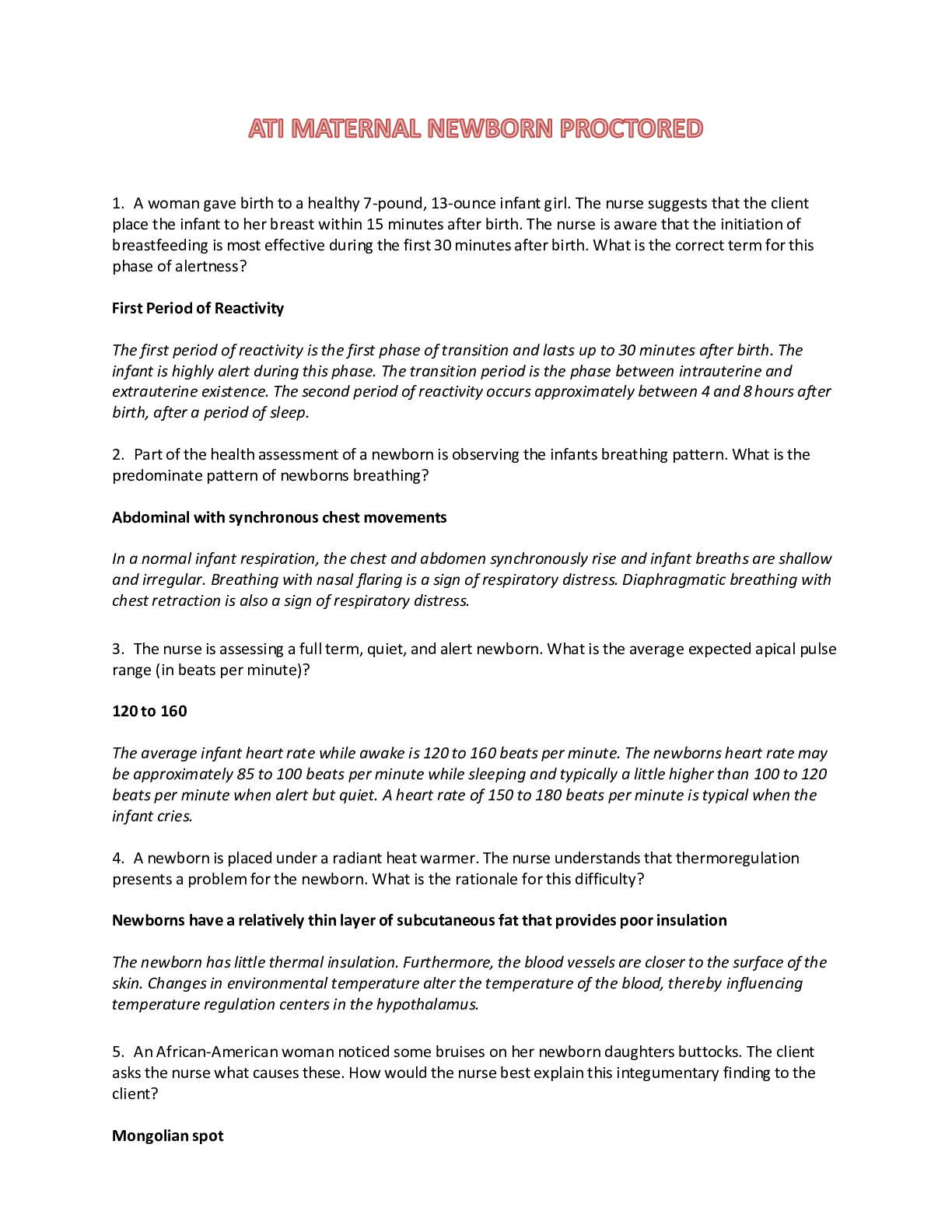Biology > STUDY GUIDE > BIOL 102 Chapter 4 Study guide latest 2020 - Liberty University / BIOL 102 Chapter 4 Study guide lat (All)
BIOL 102 Chapter 4 Study guide latest 2020 - Liberty University / BIOL 102 Chapter 4 Study guide latest 2020
Document Content and Description Below
Chapter 4 Physical Development in Infancy CHAPTER OUTLINE Growth and Stability ♦ Physical Growth: The Rapid Advances of Infancy ♦ The Nervous System and Brain: The Foundations of Development ... ♦ Integrating the Bodily Systems: The Life Cycles of Infancy ♦ SIDS: The Unanticipated Killer Motor Development ♦ Reflexes: Our Inborn Physical Skills ♦ Motor Development in Infancy: Landmarks of Physical Achievement ♦ Nutrition in Infancy: Fueling Motor Development ♦ Breast or Bottle? ♦ Introducing Solid Foods: When and What? The Development of the Senses ♦ Visual Perception: Seeing the World ♦ Auditory Perception: The World of Sound ♦ Smell and Taste ♦ Sensitivity to Pain and Touch ♦ Multimodal Perception: Combining Individual Sensory Inputs LEARNING OBJECTIVES After you have read and studied this chapter, you should be able to answer the following questions. 1. How do the human body and nervous system develop? 2. Does the environment affect the pattern of development? 3. What developmental tasks must infants accomplish in this period? 4. What is the role of nutrition in physical development? 5. What sensory capabilities do infants possess?51 PRACTICE TEST – PRETEST Circle the correct answer for each of the following multiple choice questions and check your answers with the Answer Key at the end of this chapter. 1. What principle states that simple skills develop independently and are later integrated into more complex skills? a. proximocaudal c. continuity b. hierarchical integration d. cephalocaudal 2. Frank is 6 months old and can reach out and grab a toy with his hand, but he will not be able to pick up a small toy with his finger and thumb until he is 9 months old. This illustrates what developmental principle? a. cephalocaudal principle b. proximodistal principle c. principle of hierarchical integration d. principle of the independence of systems 3. An infant received brain damage as the result of an accident, but through various experiences the brain was able to develop to overcome most of the problems. This ability of the brain is called a. plasticity. c. sensitivity. b. kwashiorkor. d. integrity. 4. The rate of SIDS in the United States has been declining partially due to the a. respiratory occlusion reflex. b. reflexes present at birth. c. back-to-sleep guideline. d. understanding sensitive periods for the formation of sleep habits. 5. Newborns do not sleep the same amount as their parents. Approximately how long do newborns sleep each day? a. 10 hours c. 14 hours b. 12 hours d. 16 hours 6. What is the incidence of sudden infant death syndrome? a. 1 in 300 c. 1 in 1000 b. 2 in 100 d. 2 in 1000 7. Newborns react to loud noises automatically. This reaction is called the a. Babinski reflex. c. rooting reflex. b. Moro reflex. d. startle reflex. 8. Zelazo and his colleagues conducted a study in which they provided 2-week-old infants practice in walking for four sessions of 3 minutes each over a 6-week period. The results showed that the children who had the walking practice actually began to walk unaided several months earlier than those who had had no such practice. What did the researchers conclude? a. Exercise of the stepping reflex was performed qualitatively better in practiced infants than in unpracticed infants. b. Exercise of the stepping reflex helps the brain's cortex to develop the ability to walk. c. Early gains in stepping reflex are associated with proficiency in motor skills in adulthood. d. Parents should make extraordinary efforts to stimulate their infant's reflexes. 9. When does crawling typically appear? a. 3-5 months c. 8-10 months b. 6-8 months d. 10-12 months52 10. At what age can you expect a child to walk by herself? a. 8 months c. 12 months b. 10 months d. 15 months 11. On television you see a child from a poor country whose growth has stopped. This child is suffering from malnutrition and has a disease called a. anemia. c. kwashiorkor. b. marasmus. d. acetycholine deficiency. 12. What is the best form of nourishment for infants under the age of one? a. bottle formula c. cereals b. breast milk d. All of the answers are correct. 13. By the age of 5 months, the average infant’s birth weight has _____ to around _____ pounds. a. doubled; 22 c. doubled; 15 b. tripled; 15 d. tripled; 22 14. The gap between neurons through which they communicate with each other is the a. synapse. c. dendrite. b. myelin. d. axon. 15. What specific skill permits infants to pinpoint the direction from which a sound is emanating? a. sensation c. sound habituation b. perception d. sound localization 16. Which of the following reflexes is permanent? a. rooting c. stepping b. sucking d. swimming 17. In the United States the poverty rate for children under the age of 3 has a. decreased. c. stabilized. b. remained the same. d. increased. 18. Joan’s baby has stopped growing due to a lack of stimulation and attention. Her baby is suffering from a. marasmus. c. nonorganic failure to thrive. b. kwashiorkor. d. SIDS. 19. Who developed the visual cliff? a. Gibson c. Fantz b. Pavlov d. Skinner 20. Which of the following is an example of a gross motor skill? a. rolling over c. coping circles b. placing a peg in a board d. pincer grasp KEY NAMES Match the following names with the most accurate description and check your answers with the Answer Key at the end of this chapter. 1. ___ Esther Thelen a. “blooming, buzzing confusion” 2. ___ Robert Fantz b. Dynamic systems theory 3. ___ Eleanor Gibson c. SID S53 4. ___ William James d. visual preferences 5. ___ Lewis Lipsitt e. visual cliff KEY VOCABULARY TERMS Explain the difference between the following pairs of terms. 1. Cephalocaudal principle; Proximodistal principle 2. Principle of hierarchical integration; Principle of the independence of systems 3. Marasmus; Kwashiorkor 4. Sensation; Perception How are the following terms related? 5. Neuron, Myelin, Synapse Fill in the blanks next to each definition with the appropriate term. The first letter of each term from top to bottom will spell out the term for the final definition. (NOTE: Some terms may be from previous chapters.) 6. _ _ _ _ _ _ _ _ _ _ The degree to which a developing structure or behavior is modifiable due to experience. _ _ _ Freud’s term for the rational part of the personality. _ _ _ _ _ _ _ _ Unlearned, organized, involuntary responses that occur automatically in the presence of certain stimuli. _ _ _ _ _ _ _ _ The upper layer of the brain is the _____ cortex. _ _ _ _ _ _ _ _ _ _ An incision made to increase the vaginal opening to allow the baby to pass during birth. _ _ _ _ _ _ _ _ _ _ _ _ _ Growth from the center of the body outward. _ _ _ _ _ _ In nonorganic failure to _____, infants stop growing due to a lack of stimulation and attention. _ _ _ _ _ _ SIDS or sudden ____ death syndrome occurs in the first year of life. _ _ _ _ _ _ _ A form of conditioning in which a response is strengthened or weakened depending on its consequences. _ _ _ _ _ The average performance of a large sample of children of a given age. The sorting out, interpretation, analysis, and integration of stimuli involving the sense organs and brain is _ _ _ _ _ _ _ _ _ _. Look up the definitions of each of the following terms and write a specific example of each. 7. SIDS 12. Sensitive period 8. Rhythms 13. Rapid eye movement (REM) 9. Infant states 14. Brazelton Neonatal Behavioral Scale54 10. Multimodal approach to perception 15. Nonorganic failure to thrive 11. Affordances 16. Dynamic system theory PROGRAMMED REVIEW Fill in the blanks in the following programmed review and check your answers with the Answer Key at the end of this chapter. Growth and Stability 1. The average newborn weighs just over ______ pounds and its length is ______ inches. Physical Growth: The Rapid Advances of Infancy 2. Over the first two years of a human’s life, growth occurs at a ______ pace. By the age of 5 months, the average infant’s birthweight has ______, and by the first birthday, weight has ______. By the end of its second year, the average child weighs ______ times its birthweight. Of course there is a good deal of variation among infants. 3. By the end of the first year, the typical baby is ______ inches tall, and by its second birthday, the child usually has attained a height of _____ feet. 4. There are gender and ethnic differences in weight and length. Girls are slightly ____ and weigh slightly ____ than boys; furthermore, Asian infants tend to be slightly _____ than North American Caucasian infants, and African American infants tend to be slightly ______ than North American Caucasian infants. 5. Four major principles govern infant growth. According to the ______ principle, growth follows a pattern that begins with the head and upper body parts and then proceeds to the rest of the body. According to the ______ principle, development proceeds from the center of the body outward. The principle of ______ integration states that simple skills typically develop separately and independently. The principle of ______ of systems suggests that different body systems grow at different rates. The Nervous System and Brain: The Foundations of Development 6. The nervous system comprises the ______ and the ______ that extend throughout the body. Like all cells, neurons have a cell body containing a ______. They communicate using ______ to receive messages and an _____ to carry messages. Neurons communicate by means of _____ that travel across small gaps, know as _____, between neurons. 7. Infants are born with between _____ billion neurons. Unused neurons are eliminated in a process called synaptic _____. The result of this process allows established neurons to build more elaborate _____ networks with other neurons. 8. After birth, neurons continue to ______ in size and become coated with ______, the fatty substance that helps insulate them and speeds the transmission of nerve impulses. The brain ______ its weight in the first two years and reaches more than ______ of adult weight and size by the age of two. 9. Neurons become arranged by ______. Some move into the ______ cortex, the upper layer of the brain, and others move to ______ levels. 10. Synapses and myelinization experience a growth spurt at around ___ to ____ months in the areas of the cortex involving auditory and visual skills (areas called the _____ cortex and the ______ cortex).55 11. _____ ________ Syndrome, a devastating injury that comes from a form of child abuse in which an infant is shaken by a caretaker, can lead the ____ to rotate within the skull, causing _____ vessels to tear and destroying the intricate connections between neurons. 12. The brain’s _____, or degree to which a developing structure or behavior is modifiable due to experience, is relatively great for the brain. A ______ period is a specific but limited time during which the organism is particularly susceptible to environmental influences. Integrating the Bodily Systems: The Life Cycles of Infancy 13. One of the most important ways that behavior becomes integrated is through the development of various body ______, repetitive cyclical patterns of behavior. An infant’s ______ is the degree of awareness it displays to both internal and external stimulation. 14. Some of the different states that infants experience produce changes in ______ activity in the brain reflected in different patterns of brain ______ which can be measured by an ______. 15. On average, newborn infants sleep ______ hours a day. They experience a period of active sleep similar though not identical to ______ eye movement or REM sleep found in older children and adults. REM sleep provides a means for the brain to stimulate itself, a process called ______. SIDS: The Unanticipated Killer 16. When seemingly healthy infants die in their sleep, it is probably due to ______ infant death syndrome (SIDS). The number of SIDS deaths has decreased since the American Academy of Pediatrics suggests the _____ guideline that babies sleep on their back. SIDS is the leading cause of death in children under the age of _____. Lipsitt believes that SIDS hinges on infant reflexes, specially the _____ occlusion reflex. Motor Development Reflexes: Our Inborn Physical Skills 17. Reflexes are _____, organized involuntary responses that occur automatically in the presence of certain stimuli. The ______ reflex makes a baby who is lying face down in a body of water paddle and kick. The ______ reflex seems designed to protect the eye from too much direct light. Researchers who focus on evolutionary explanations of development attribute the gradual disappearance of reflexes to the increase in ______ control over behavior. 18. Reflexes are ______ determined and ______ throughout all infants. The _____ reflex is activated when support for the neck and head is suddenly removed. There are some ______ variations in the ways they are displayed however. Reflexes can serve as helpful ______ tools for pediatricians. Motor Development in Infancy: Landmarks of Physical Achievement 19. By the age of _____ months, many infants become rather accomplished at moving themselves in particular directions. Crawling appears typically between _____ months. At around the age of ______ months, most infants are able to walk by supporting themselves on furniture. Babies are able to sit without support by the age of ______ months. 20. By the age of ______ months, infants show some ability to coordinate the movements of their limbs. By the age of _____ months, infants are able to pick small objects off the ground, and by the time they are _____ old, they can drink from a cup. Infants first begin picking up things with their whole hand, but as they get older they use a _____ grasp where the thumb and index finger meet to form a circle. 21. The _____ systems theory described how motor behaviors are assembled. This theory is noteworthy for its emphasis on a child’s own _____.56 22. The timing of the milestones is based on ______, the average performance of a large sample of children at a given age. One of the most widely used techniques to determine infants’ normative standing is the ______ Neonatal Behavior Assessment Scale, a measure designed to determine infants’ ______ and behavioral responses to their environment. 23. Variations in the timing of motor skills seem to depend in part on parental ______ of what is the appropriate schedule for the emergence of specific skills that is, by ______ factors. However, there are certain ______ determined constraints on how early a skill can emerge. Nutrition in Infancy: Fueling Motor Development 24. The rapid physical growth that occurs during infancy is fueled by the ______ that infants receive. ______ is the condition of having an improper amount and balance of nutrients. Children who have been chronically malnourished during infancy later score lower on _____ tests and tend to do less well in ______. The problem of malnutrition is greatest in ______ countries. 25. Some ______ children live in poverty in the United States and the poverty rate for children under the age of _____ has increased. Although these children rarely become severely malnourished, they are susceptible to [Show More]
Last updated: 1 year ago
Preview 1 out of 15 pages

Reviews( 0 )
Document information
Connected school, study & course
About the document
Uploaded On
May 28, 2020
Number of pages
15
Written in
Additional information
This document has been written for:
Uploaded
May 28, 2020
Downloads
0
Views
43

